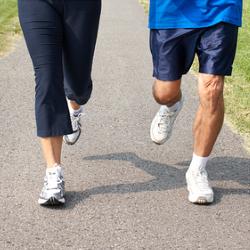Most experts agree to reap the health benefits from walking, you have to walk at least at a brisk pace. But what is considered “brisk”?
Because a brisk pace depends on the amount of exertion put forth while walking, it depends on your fitness level. What may be brisk for someone just starting out walking, will not be the same as for someone that has been doing it for a long time.
Regardless if you are new to the sport or not, you have to use some method of “measuring” your walking to know if you are making progress or not. Walking is measured in two ways – either by intensity or pace.
Intensity When Walking
Using this method, your intensity should be moderate, meaning you should get your heart rate up to 50% to 70% of your maximum heart rate (220 – age). Once you have your target heart rate figure, then monitor your pulse (count the number of beats during a 10 second period and multiply by 6) and adjust your pace as necessary to keep it within your range. Another way to roughly calculate if you are within your range or not is you should be able to speak in full sentences while walking, but unable to sing a song.
Pace Yourself When You Walk
This method uses a calculation of distance covered over a span of time. A brisk pace for people new to walking starts at about three miles per hour, breaking down to 20 minutes per mile or about 12 minutes per kilometer. As your fitness level increases, you can quicken your pace to four miles per hour – 15 minutes per mile or 9 minutes and 15 seconds per kilometer.
Keeping Track of Progress
While you can measure your pace with just a wristwatch, by keeping track of how long it takes you to make it around a measured course, there are an array of tools to help you monitor your progress. From simple online calculators, to electronic devices, to smartphone applications, there is something for everyone to measure time and distance, pace or the intensity level of your walking.
When coupled with a healthy diet, walking may be the perfect exercise for weight loss. All that is required for equipment is good pair of walking shoes; everything else is nice to have, but optional.
And walking can be incorporated into your normal daily routine. Park at the end of the parking lot and walk the rest of the way to work, or if you take public transportation to and from work, get off a stop or two further away and walk to work.
If you’d like to get more out of your walking for fitness plan, check out the “Guide to Setting Your Walking Fitness Goals” for more in depth knowledge on the subject of walking for fitness. While you’re there, be sure to sign up for the free MyFitnessNut.com Newsletter to be kept up to date on the latest health and fitness topics.









